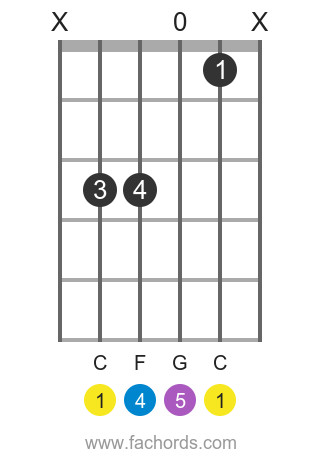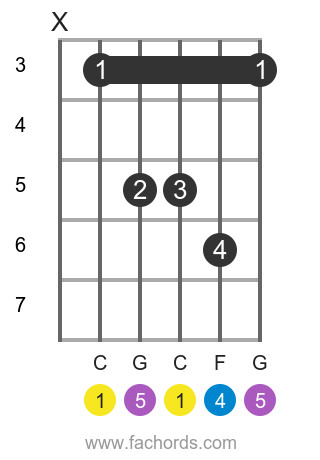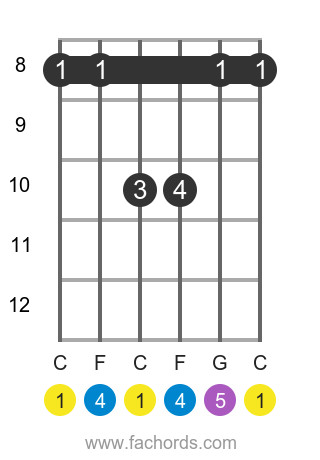The C sus4 chord is a captivating and versatile chord in the world of guitar playing. Falling under the suspended chords category, its unique character stems from the absence of the third interval, replaced instead by the fourth. This means the C sus4 chord is beautifully constructed from three fundamental notes: C, F, and G. In musical intervals, these are known as the Root (1), the Perfect Fourth (4), and the Perfect Fifth (5).
If terms like “intervals” and “chord construction” are new to you, don’t worry! We highly recommend exploring our comprehensive guide on building chords using intervals. This resource will lay a solid foundation in music theory, making chords like the C sus4, and many others, much easier to grasp.
 C sus4 chord open position guitar diagram – guitarplayers.net
C sus4 chord open position guitar diagram – guitarplayers.net
For those already comfortable with music theory, you’ll recognize the Perfect Fourth and Perfect Fifth as the secret ingredients behind the C sus4’s distinctive, open sound. To deepen your understanding of these and other crucial intervals, our fretboard intervals tutorial is an invaluable resource.
Learning the C sus4 chord is a fantastic step for guitarists aiming to move beyond basic chords. Its widespread use across diverse musical genres makes it an essential addition to your chord vocabulary. Mastering the C sus4 opens up a wider range of songs and musical expressions. To further explore the fascinating world of suspended chords, our dedicated suspended chords tutorial offers even more insights.
Once you feel confident playing the C sus4 chord, challenge yourself with our interactive chord identifier tool. This tool allows you to input chord shapes from the fretboard and test your knowledge, ensuring you’re accurately playing the chords you learn.
We trust this introduction has provided you with a clear understanding of the C sus4 chord and its significance. Now, let’s delve into the practical aspects and learn how to play this expressive chord on your guitar!
Decoding the C sus4 Chord: Notes and Formula
The C sus4 chord is built upon a simple yet effective structure. Let’s break down the components:
Notes in the C sus4 chord:
- C
- F
- G
These three notes combine to create the suspended sound we associate with the C sus4.
Chord formula for the Suspended Fourth chord:
The formula visually represents the intervals that construct a suspended fourth chord:
- 1 (Root)
- 4 (Perfect Fourth)
- 5 (Perfect Fifth)
This formula applies to all sus4 chords, regardless of the root note. The ‘sus4’ designation always indicates the presence of the fourth interval instead of the major or minor third.
Chord diagrams, often called chord boxes, visually represent how to play chords on the guitar fretboard. They are typically arranged from the easiest to more challenging positions. If you are new to reading these diagrams, our tutorial on how to read chord diagrams will be very helpful. And if barre chords present a challenge, our Bar Chords Tips tutorial offers valuable techniques and advice.
For a text-based representation of chord positions, you can also visit our accessible chords page which provides written diagrams.
Mastering C sus4 Positions on Guitar
Let’s explore different positions to play the C sus4 chord on the guitar fretboard.
Position 1: Open Position
This is often the first C sus4 position guitarists learn due to its simplicity.
 C sus4 chord open position guitar diagram – guitarplayers.net
C sus4 chord open position guitar diagram – guitarplayers.net
- Fingering:
- Index finger: 2nd fret of the A string (5th string)
- Middle finger: 3rd fret of the B string (2nd string)
- Ring finger: 3rd fret of the high E string (1st string)
- Strumming: Strum all six strings.
- Sound: Produces a bright and open C sus4 sound, ideal for many musical contexts.
Position 2: Barre Chord (Movable Shape)
This position utilizes a barre chord shape, making it movable up and down the neck to play other sus4 chords.
 C sus4 chord barre position 2 guitar diagram – movable shape for guitar
C sus4 chord barre position 2 guitar diagram – movable shape for guitar
- Fingering:
- Barre your index finger across the 3rd fret (strings 1-6).
- Ring finger: 5th fret of the A string (5th string)
- Pinky finger: 5th fret of the D string (4th string)
- Strumming: Strum all six strings.
- Sound: A fuller, richer C sus4 sound, suitable for when you need more volume and sustain. Being movable, this shape is incredibly useful.
Position 3: Barre Chord Variation (Movable Shape)
Another movable barre chord variation, offering a different voicing of the C sus4.
 C sus4 chord barre position 3 guitar diagram – learn guitar chords online
C sus4 chord barre position 3 guitar diagram – learn guitar chords online
- Fingering:
- Barre your index finger across the 8th fret (strings 1-5).
- Ring finger: 10th fret of the D string (4th string)
- Pinky finger: 10th fret of the G string (3rd string)
- Strumming: Strum strings 6 to 1 (or strings 5 to 1 for a slightly different voicing).
- Sound: A higher-pitched C sus4 voicing, great for adding variety and texture to your playing.
Explore our extensive guitar chords library for even more chord shapes. For a handy reference offline, download our Free Guitar Chords Chart Pdf.
Expanding Your Musical Palette with C sus4
Once you’re comfortable with these C sus4 positions, experiment with playing it with different root notes. Below are links to sus4 chords with various roots:
C sus4 | D sus4 | E sus4 | F sus4 | G sus4 | A sus4 | B sus4 | C#sus4 | D#sus4 | F#sus4 | G#sus4 | A#sus4 | Absus4 | Bbsus4 | Dbsus4 | Ebsus4 | Gbsus4
Utilize the fretboard map provided in the original article to discover even more ways to voice the C sus4 chord and incorporate it into your music. Experiment with different strumming patterns and chord progressions to truly unlock the potential of the C sus4 chord!
